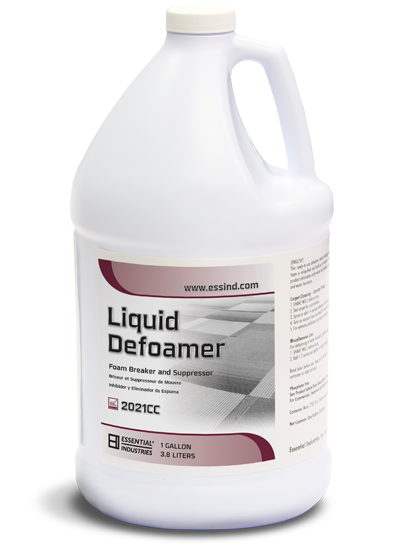Why Opting for a High-Quality Chemical Defoamer Is Important for Your Operations
Why Opting for a High-Quality Chemical Defoamer Is Important for Your Operations
Blog Article
Understanding Exactly How a Chemical Defoamer Functions to Enhance Industrial Processes
Chemical defoamers play a critical function in maximizing commercial processes by efficiently alleviating foam-related obstacles. Their capacity to lower surface tension and interrupt bubble formation translates into smoother operations and improved performance. Nonetheless, the mechanisms behind their action and the variety of available formulas call for a closer assessment. Chemical Defoamer. Understanding these aspects could reveal significant insights into not only enhancing production but also achieving cost savings across numerous sectors. What continues to be to be discovered is exactly how these defoamers can be customized to fulfill certain functional demands.
What Is a Chemical Defoamer?
A chemical defoamer is a material especially developed to remove the formation or reduce of foam in numerous industrial processes. Frothing can hinder production efficiency, influencing the top quality and efficiency of products in fields such as food and beverage, drugs, and wastewater therapy. Defoamers are essential in these applications, as excessive foam can bring about operational challenges, such as overflow, lowered mixing efficiency, and prevented heat transfer.
The choice of an ideal defoamer is vital, as various formulations may be customized for specific procedures or kinds of foam. Elements such as compatibility with various other ingredients, temperature security, and the desired application play a considerable duty in the effectiveness of a defoamer.
Mechanisms of Defoaming Activity
The systems of defoaming activity involve complex interactions between the foam and the defoamer framework. When a defoamer is presented to a frothing system, it moves rapidly to the surface of the foam bubbles, displacing the supporting agents that contribute to foam stability.
As smaller bubbles merge into larger ones, the general security of the foam reduces. In addition, certain defoamers may include hydrophobic elements that improve their capability to undercut the foam by producing an obstacle that prevents bubble development. This double action-- surface area stress decrease and destabilization-- enables a much more efficient failure of foam.

Additionally, the thickness and spreading qualities of the defoamer play essential roles in its effectiveness. A well-formulated defoamer will ensure quick movement and ideal performance, minimizing foam development throughout industrial processes. By recognizing these systems, markets can better select and use chemical defoamers to enhance operational performance and item high quality.
Types of Chemical Defoamers
Chemical defoamers can be classified into several kinds, each tailored to specific applications and foam challenges. The key categories include silicone-based, non-silicone-based, and powder defoamers.
Silicone-based defoamers are extremely effective due to their capability to spread out quickly across my company fluid surfaces. Non-silicone-based defoamers, on the various other hand, typically rely on organic substances like fatty acids or esters.
Powder defoamers include strong particles that can be included to dry procedures or solutions. They are typically made use of in processes where fluid defoamers might not be efficient, giving a distinct remedy for particular applications, such as in the manufacturing of particular sorts of plastics or powders.
In addition, each type of defoamer can be personalized with numerous additives to boost performance, such as emulsifiers or surfactants, enabling convenience in addressing different lathering circumstances across numerous industries.
Applications in Industrial Processes

In the food and beverage industry, defoamers are vital during the production of juices, beers, and milk products, where too much foam can impede blending and filtering processes. By lowering foam formation, defoamers aid preserve consistent item quality and enhance processing times.
In drugs, the presence of foam throughout the mixing and solution of medicines can influence dosage precision and product security. Defoamers guarantee smooth procedures, thus promoting the manufacturing of high-grade pharmaceuticals.
Wastewater therapy facilities likewise depend on defoamers to control frothing in aeration storage tanks, which can or else decrease therapy efficiency and make complex sludge handling. By effectively managing foam, these chemicals boost the overall performance of therapy processes and add to governing compliance.

Benefits of Making Use Of Defoamers
While foam can present significant challenges throughout various industries, making use of defoamers find this uses many advantages that improve operational efficiency and item honesty. Defoamers properly eliminate or reduce foam formation, resulting in smoother production procedures and enhanced product quality. This decrease in foam lessens interruptions during production, enabling for constant operation and raised throughput.
Additionally, the application of defoamers can result in set you back financial savings by reducing the need for excess basic materials and energy consumption connected with foam administration. By optimizing the manufacturing process, manufacturers can attain higher returns and lower waste, eventually improving productivity.
In addition, defoamers add to better tools performance. Foam build-up can result in clogging, overflow, and devices wear, resulting in expensive downtime and maintenance. By stopping these issues, defoamers prolong the lifespan of equipment and reduce functional costs.
Final Thought

A chemical defoamer is a compound specifically created to minimize or eliminate the development of foam in different industrial procedures. When a defoamer is introduced to a frothing system, it migrates rapidly to the surface area of the foam bubbles, displacing the stabilizing representatives that contribute to foam stability. A well-formulated defoamer will certainly guarantee quick migration and optimum efficiency, minimizing foam development during commercial processes. Defoamers properly get rid of or reduce foam formation, leading to smoother manufacturing processes and boosted product top quality.In conclusion, chemical defoamers play an essential function in boosting industrial procedures by effectively minimizing foam development.
Report this page